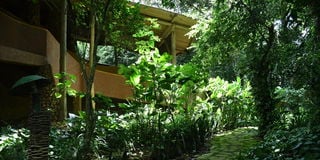Here is how to make your garden thrive

With care one can turn their compound into a green haven. PHOTO/EDGAR R. BATTE.
What you need to know:
The key to creating a garden begins with inspiration. Whether you want something wild, whimsical or a garden that is in bloom all year round, start by choosing a suitable location.
A beautiful garden has endless benefits and with proper planning it is achievable. Carina Musila, an architectural designer says before starting a flower bed, plan ahead and visualise the future.
“The key to creating a garden begins with inspiration. Whether you want something wild, whimsical or a garden that is in bloom all year round, start by taking a stroll around your property and choosing a suitable location. Next, choose the plants that suit the space you have chosen,” Musila advises.
How much sun does the spot you have chosen get? The perfect space for a garden should receive at least five to six hours of direct sunlight. Avoid spaces that receive strong winds as the winds can easily uproot the budding plants and prevent the pollinators from doing their job. Many novice gardeners get disappointed when their plant leaves begin to dry or their growth becomes compromised, but all those are hints that the plants were placed in the wrong location.
Soil test
Emmanuel Aleko, a landscape designer with Roots2Petals Gardening, notes that it is important for one to have their soil tested to determine which crops will thrive in it. What is the soil like? For thriving plant life, one needs healthy soil that is not compacted and that drains well. You can tell soil has good drainage when after it rains, the water does not pool. Similarly, the soil should not be so difficult to dig into.
“Many people choose plants guided by their preference, but for gardening success, avoid wasting money on plants that will not be supported by your soil type. Test the soil in different areas of your property, as pH and nutrient levels may vary in even a relatively small space and have different feeding requirements,” Aleko says.
However, there is a possibility of using organic matter such as compost to provide nutrients and improve soil structure.
Purpose and design
Artist and interior designer, Sheila Nakitende says another important consideration is the purpose for which the garden will serve. “Is it a flower or fruits and vegetable garden? The good thing is one can have a multi-purpose where you plant both flowers and edible plants,” she says.
A well planned garden serves many functions such as provision of food, reducing pollution and adding aesthetic value to the home. Aleko also explains that once the purpose of the garden has been established the next consideration is proper design. Even if you have limited space, a professional can help you incorporate all the things you want from a garden.
Brenda Mpiirwa, a lead interior designer at K’wanzi Accents advises that it is good to demarcate space for the garden right from inception. She explains,
“When engaging architects for structural plans, it is important to mention your desire for greenery. For large and professional gardens, it better to engage the services of a landscape designer,” says Mpiirwa.
Seek advice
Mpiirwa says starting a garden can be both exciting and daunting so to avoid making mistakes one should seek form experts.
She observes, “There are people with green fingers willing to share such information. If you desire a large home garden, it may be very wise to go as far as have a 3D impression to visualise your dream. This will usually come at a cost but will bring you closer to your desired garden faster.”
Choose plants
Understanding the plants and types of the numerous grass available and which a person would like to have and how to maintain them is key. A garden can have a lawn-grass area, and Aleko notes that the different types of grass serve different purposes. In making a choice of the plants to have, interior designer, Luwemba says the basic fact is that most plants add beauty but location is key.
“For example, cycads and palm trees are considered one of the beautiful plants but if I put a cycad in the wrong place, it will not look nice. If I put it as an accent piece in a spacious place, it will be beautiful and unique. As an interior designer, I work with various landscapers on different projects. We are cautious not to plant poisonous plants or trees in a home because a child can pluck off a leaf, eat it or play with,” says Aleko. He adds that care in choice of plants is crucial in order to create beauty but also consider the wellbeing of the home residents.
Colour
Colour is also another important factor in choosing plants for your garden. For example irises are popular for their variety in colours. “Irises come in every single colour of the rainbow and their heights range from a few inches tall to up to five feet so they can be planted in the middle, back, or front of borders, in rock gardens, and all kinds of garden settings. They also grow fast so you can divide and transplant elsewhere in your garden that you can benefit from their colour,” she notes.
Mpiirwa suggests plants that are multipurpose and require low maintenance and have some healing properties.
Research
If you prefer to do it yourself, Emmanuel Aleko suggest doing some online research to guide you on things such as preparation of the site and purchase of plants from the nursery.





